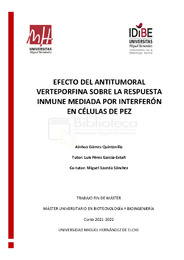Please use this identifier to cite or link to this item:
https://hdl.handle.net/11000/28331Full metadata record
| DC Field | Value | Language |
|---|---|---|
| dc.contributor.advisor | Pérez García-Estañ, Luis | - |
| dc.contributor.advisor | Saceda Sánchez, Miguel | - |
| dc.contributor.author | Gómez Quintanilla, Ainhoa | - |
| dc.contributor.other | Departamentos de la UMH::Biología Aplicada | es_ES |
| dc.date.accessioned | 2022-11-11T11:20:16Z | - |
| dc.date.available | 2022-11-11T11:20:16Z | - |
| dc.date.created | 2022-06-28 | - |
| dc.identifier.uri | https://hdl.handle.net/11000/28331 | - |
| dc.description.abstract | Existen evidencias de una interconexión entre el desarrollo del cáncer y el sistema inmunológico. Hemos investigado en este trabajo está posible conexión usando el modelo VTPF-SVCV-EPC. El antitumoral VTPF es un inhibidor de la vía Hippo-YAP, una ruta que se encuentra sobreexpresada en muchos tipos de cáncer de la que se ha sugerido que tenga un papel en la inhibición del virus SARS-CoV2. Por tanto, hemos decidido usar este antitumoral con la finalidad de evaluar su efecto sobre la infección con el virus de la viremia primaveral de la carpa (SVCV) en la línea celular de pez (EPC). Nuestros resultados muestran la inhibición de la replicación viral por VTPF en los ensayos de qPCR (pero no de formación de calvas) y la estimulación por VTPF de la expresión de genes relacionados con la respuesta inmune innata. Además, para profundizar más en el papel de VTPF sobre la vía del interferón hemos usado un estimulador de dicha vía como es el poly I:C, viendo cómo VTPF actúa sobre su acción antiviral, en concreto en lo que se refiere a la expresión de genes relacionados con esta vía como son las proteínas transmembrana inducidas por interferón (IFITM). | es_ES |
| dc.description.abstract | There is evidence for an interplay between cancer development and the immune system. We have investigated in this work this possible connection using the VTPF-SVCVEPC model. The antitumor VTPF is an inhibitor of the Hippo-YAP, a pathway that is overexpressed in many types of cancer and has been suggested to play a role in the inhibition of SARS-CoV2 virus. Therefore, we have decided to use this antitumor in order to evaluate its effect on infection with spring viraemia of carp virus (SVCV) in the fish cell line (EPC). Our results show the inhibition of viral replication by VTPF in qPCR assays (but not baldness formation) and the stimulation by VTPF of the expression of genes related to the innate immune response. In addition, to further investigate the role of VTPF on the interferon pathway, we have used a stimulator of this pathway such as poly I:C, to see how VTPF acts on its antiviral action, specifically with regard to the expression of genes related to this pathway such as interferon-induced transmembrane proteins (IFITM). | es_ES |
| dc.format | application/pdf | es_ES |
| dc.format.extent | 50 | es_ES |
| dc.language.iso | spa | es_ES |
| dc.publisher | Universidad Miguel Hernández de Elche | es_ES |
| dc.rights | info:eu-repo/semantics/openAccess | es_ES |
| dc.rights | Attribution-NonCommercial-NoDerivatives 4.0 Internacional | * |
| dc.rights.uri | http://creativecommons.org/licenses/by-nc-nd/4.0/ | * |
| dc.subject | antitumoral | es_ES |
| dc.subject | SVCV | es_ES |
| dc.subject | virus de pez | es_ES |
| dc.subject | respuesta inmune | es_ES |
| dc.subject | IFITM | es_ES |
| dc.subject.other | CDU::6 - Ciencias aplicadas | es_ES |
| dc.title | Efecto del antitumoral verteporfina sobre la respuesta inmune mediada por interferón en células de pez | es_ES |
| dc.type | info:eu-repo/semantics/masterThesis | es_ES |

View/Open:
227 GÓMEZ QUINTANILLA,AINHOA-Memoria TFM.pdf
5,23 MB
Adobe PDF
Share:
.png)
